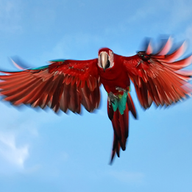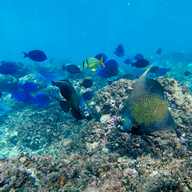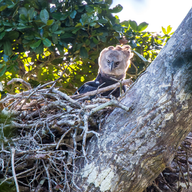Is Nature Culture?
- Leonardo Merçon

- Oct 7
- 5 min read

A Reflection...
The disconnection between cultural and environmental sectors still limits the transformative potential of art in Brazil.
As a nature photographer and cultural producer who has spent the past 20 years trying to inspire people through images, music, film, festivals, and the art of storytelling, one question continues to haunt me: why do people still insist on separating culture and the environment?
I understand that those working in contemporary art may have their own ways of expressing creativity — but art and culture are not limited to a single form or movement.
With every new proposal, exhibition, or project that involves the environment and environmental education through artistic language, I often hear: “That’s not culture, that’s environmental work.” As if using nature as a theme automatically stripped my work of its artistic value.
I’ve been told that what I do “isn’t art,” because it’s “too beautiful” or “too full of nature.” “Art has to shock,” they say.
What’s most curious is that these criticisms often come from within the cultural sector itself — from curators, evaluators, artists, and academics who refuse to recognize nature as a legitimate subject of artistic expression. It’s as if culture existed apart from the land, the forest, the rivers, and everything that has shaped us as a society.
On the other hand, I’ve also heard from environmental professionals that my work “isn’t environmental,” because it’s “too artistic.”
When Culture Disconnects from Life
Art exists to express ideas, emotions, conflicts, and dreams. Yet it’s ironic that the same contemporary art world that prides itself on being revolutionary, provocative, and critical so often reproduces a narrow view of what culture really is.
Themes like politics, social class, gender, and race are rightly embraced as legitimate forms of artistic expression. But when art speaks about nature, forests, biodiversity, or conservation, it’s often dismissed as “environmental education” or “science.”
Why is a project about social issues immediately considered “culture” — as it should be — but one that exposes the destruction of ecosystems is seen as “just environmental”? Have we forgotten that culture itself is a product of our relationship with the environment we live in?
Nature photographs used to raise awareness of various environmental causes in Espírito Santo over the past decades | Photos: Leonardo Merçon
Culture is in the Themes, Not in the Formats
The connection between nature and culture goes back to the very first artistic expressions of humankind.
Cave paintings weren’t born in galleries — they emerged inside the earth itself, in caves. Singing, dancing, sculpture, and literature were all profoundly influenced by landscapes, animals, forests, and natural forces.
Nature has been a theme of art since before the word “art” even existed — it was there with our ancestors. It’s also found in the poems of Gonçalves Dias, in the brushstrokes of Van Gogh, and in Monet’s impressionist landscapes. It’s present in the photographs of Sebastião Salgado, especially in his “Genesis” series, entirely dedicated to natural landscapes, wildlife, and forest peoples.
And it lives on in my own cultural productions — works created with passion and purpose, using environmental themes to move people and make them see differently.
Art as a Bridge Between Worlds
To me, my work is both artistic and cultural. When I transform a photograph into a book, an exhibition, a documentary, or a festival, I am creating culture from nature.
I’m reaching people not through data, but through visual storytelling — through emotion, aesthetics, and interaction with Brazil’s natural and cultural heritage. There is nothing purely technical or scientific about that. THERE IS ALSO ART .
Nature photographs created to convey the message of conservation, taken over 20 years of work using art as a tool for nature conservation |Photos: Leonardo Merçon
Cultural production that uses nature as a theme isn’t environmental pamphleteering — it’s a way of giving voice to silenced stories. It gives life to endangered landscapes, invisible species, and the territories that sustain us. It’s art that proposes a new ethic — culture that expands our perception of the world.
Cultural activities using nature as a theme to engage the community and promote local territories. Photos: Instituto Últimos Refúgios team
Nature Is at the Core of Brazilian Culture
Culture is what we eat, where we live, how we speak, how we pray, how we fight, how we care for — or destroy — what surrounds us. Nature runs through all of these dimensions. To separate nature from culture is to amputate a part of who we are.
This connection between nature and culture isn’t only poetic — it’s also recognized by Brazilian law. The National Plan for Culture (Law No. 12.343/2010) establishes social and environmental responsibility as a principle and recognizes culture as a driver of sustainable development. Among its goals is to encourage socio-environmental sustainability and to value artistic creation in all its diversity.
Furthermore, Article 216 of the Federal Constitution defines Brazilian cultural heritage as not only artistic creations, but also ecological sites, traditional knowledge, and manifestations that embody the memory and identity of different social groups.
In other words: nature is culture — by law, by history, and by essence. There is no Brazilian culture without the Atlantic Forest (Mata Atlântica), the Cerrado, the Amazon, the Pantanal, the Pampas, the Caatinga, the sea, the rivers, the mangroves, or the mountains. There is no identity without territory.
We Need to Broaden the Horizons of Culture
It’s time to move beyond the reductionist view that confines art to rigid boxes and treats the environment as an educational accessory. Cultural projects that deal with nature are just as valid as any other. They reconnect us with what is essential. They remind us of where we come from. They deserve to be supported by cultural policies.
An artist communicates messages about what matters in their life — about issues that shape society and define our times. And amid a climate crisis that threatens our very survival, the conservation of nature is one of the most vital themes of our era. That, to me, is one of the purposes of art.
As an artist, photographer, cultural producer, and environmentalist, I continue to build bridges through culture — but I’m tired of having to defend the idea that touching people through the beauty of nature is as much art as anything hanging on a gallery’s white wall.
I believe that a culture that ignores nature is incomplete. Art doesn’t need permission to speak about what is essential. And the conservation of nature is essential.
May our society learn to see that — before all that remains is the silence of what’s left behind.

Nature photographer and cinematographer, founder of Instituto Últimos Refúgios, Master in Biodiversity Conservation and Sustainable Development, passionate about the environment! Join me on this incredible journey of wildlife discoveries and see more beautiful stories as I constantly explore nature.










































































































Comments